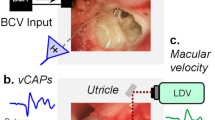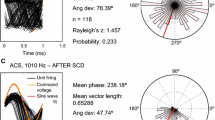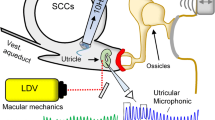Abstract
The classical view of the otoliths—as flat plates of fairly uniform receptors activated by linear acceleration dragging on otoconia and so deflecting the receptor hair bundles—has been replaced by new anatomical and physiological evidence which shows that the maculae are much more complex. There is anatomical spatial differentiation across the macula in terms of receptor types, hair bundle heights, stiffness and attachment to the overlying otolithic membrane. This anatomical spatial differentiation corresponds to the neural spatial differentiation of response dynamics from the receptors and afferents from different regions of the otolithic maculae. Specifically, receptors in a specialized band of cells, the striola, are predominantly type I receptors, with short, stiff hair bundles and looser attachment to the overlying otoconial membrane than extrastriolar receptors. At the striola the hair bundles project into holes in the otolithic membrane, allowing for fluid displacement to deflect the hair bundles and activate the cell. This review shows the anatomical and physiological evidence supporting the hypothesis that fluid displacement, generated by sound or vibration, deflects the short stiff hair bundles of type I receptors at the striola, resulting in neural activation of the irregular afferents innervating them. So these afferents are activated by sound or vibration and show phase-locking to individual cycles of the sound or vibration stimulus up to frequencies above 2000 Hz, underpinning the use of sound and vibration for clinical tests of vestibular function.

Reprinted from Curthoys and Vulovic (2011). Copyright © Springer-Verlag 2010. With permission of Springer

Republished with the permission of John Wiley and Sons Inc, from Curthoys et al. (2011)

Republished with permission of John Wiley and Sons, Inc., from Curthoys (2012)

Reprinted by permission of Taylor & Francis Ltd, http://www.tandfonline.com, on behalf of Acta OtoLaryngologica AB (Ltd) from Hunter-Duvar (1983), Acta Otolaryngologica, http://www.informaworld.com

(unpublished image kindly supplied by Dr Corrie Spoon; see Spoon et al. 2011)

Reprinted from Curthoys et al. (2006). Copyright © Springer-Verlag 2006. With permission of Springer

Republished with permission of Elsevier, from Curthoys et al. (2016)

Republished with permission of Elsevier, from Curthoys et al. (2016)


Republished with permission of Elsevier, from Curthoys et al. (2016)



Republished with the permission of John Wiley and Sons Inc, from Curthoys et al. (2011)

Similar content being viewed by others
Abbreviations
- ABR:
-
Auditory brainstem response
- ACS:
-
Air-conducted sound
- BCV:
-
Bone-conducted vibration
- Fz:
-
The midline of forehead at the hairline
- IO:
-
Inferior oblique eye muscle
- VEMP:
-
Vestibular-evoked myogenic potential
- cVEMP:
-
Cervical vestibular-evoked myogenic potential
- oVEMP:
-
Ocular vestibular-evoked myogenic potential
- SCD:
-
Semicircular canal dehiscence
- n10:
-
The negative potential of the oVEMP at about 10 ms latency
- SCM:
-
Sternocleidomastoid muscle
- SVIN:
-
Skull vibration induced nystagmus
References
Brichta AM, Peterson EH (1994) Functional architecture of vestibular primary afferents from the posterior semicircular canal of a turtle, Pseudemys (trachemys) scripta elegans. J Comp Neurol 344:481–507. doi:10.1002/cne.903440402
Burgess AM, Mezey LE, Manzari L, MacDougall HG, McGarvie LA, Curthoys IS (2013) Effect of stimulus rise-time on the ocular vestibular-evoked myogenic potential to bone-conducted vibration. Ear Hear 34:799–805. doi:10.1097/AUD.0b013e318294e3d2
Carey JP, Hirvonen TP, Hullar TE, Minor LB (2004) Acoustic responses of vestibular afferents in a model of superior canal dehiscence. Otol Neurotol 25:345–352
Chagnaud BP, Bass AH (2013) Vocal corollary discharge communicates call duration to vertebrate auditory system. J Neurosci 33:18775–18780. doi:10.1523/jneurosci.3140-13.2013
Colebatch JG, Halmagyi GM (1992) Vestibular evoked potentials in human neck muscles before and after unilateral vestibular deafferentation. Neurology 42:1635–1636. doi:10.1212/WNL.42.8.1635
Colebatch JG, Halmagyi GM, Skuse NF (1994) Myogenic potentials generated by a click-evoked vestibulocollic reflex. J Neurol Neurosurg Psychiatry 57:190–197. doi:10.1136/jnnp.57.2.190
Cremer PD, Minor LB, Carey JP, Della Santina CC (2000) Eye movements in patients with superior canal dehiscence syndrome align with the abnormal canal. Neurology 55:1833–1841. doi:10.1212/wnl.55.12.1833
Curthoys IS (2010) A critical review of the neurophysiological evidence underlying clinical vestibular testing using sound, vibration and galvanic stimuli. Clin Neurophysiol 121:132–144. doi:10.1016/j.clinph.2009.09.027
Curthoys IS (2012) The interpretation of clinical tests of peripheral vestibular function. Laryngoscope 122:1342–1352. doi:10.1002/lary.23258
Curthoys IS, Grant JW (2015) How does high-frequency sound or vibration activate vestibular receptors? Exp Brain Res 233:691–699. doi:10.1007/s00221-014-4192-6
Curthoys IS, Vulovic V (2011) Vestibular primary afferent responses to sound and vibration in the guinea pig. Exp Brain Res 210:347–352. doi:10.1007/s00221-010-2499-5
Curthoys IS, Kim J, McPhedran SK, Camp AJ (2006) Bone conducted vibration selectively activates irregular primary otolithic vestibular neurons in the guinea pig. Exp Brain Res 175:256–267. doi:10.1007/s00221-006-0544-1
Curthoys IS, Vulovic V, Burgess AM, Cornell ED, Mezey LE, MacDougall HG, Manzari L, McGarvie LA (2011) The basis for using bone-conducted vibration or air-conducted sound to test otolithic function. Ann N Y Acad Sci 1233:231–241. doi:10.1111/j.1749-6632.2011.06147.x
Curthoys IS, Vulovic V, Sokolic L, Pogson J, Burgess AM (2012) Irregular primary otolith afferents from the guinea pig utricular and saccular maculae respond to both bone conducted vibration and to air conducted sound. Brain Res Bull 89:16–21. doi:10.1016/j.brainresbull.2012.07.007
Curthoys IS, Vulovic V, Burgess AM, Manzari L, Sokolic L, Pogson J, Robins M, Mezey LE, Goonetilleke S, Cornell ED, MacDougall HG (2014) Neural basis of new clinical vestibular tests: otolithic neural responses to sound and vibration. Clin Exp Pharmacol Physiol 41:371–380. doi:10.1111/1440-1681.12222
Curthoys IS, Vulovic V, Burgess AM, Sokolic L, Goonetilleke SC (2016) The response of guinea pig primary utricular and saccular irregular neurons to bone-conducted vibration (BCV) and air-conducted, sound (ACS). Hearing Res 331:131–143. doi:10.1016/j.heares.2015.10.019
de Burlet HM (1924) Zur Innervation der Macula sacculi bei Säugetieren. Anat Anzeig 58:26–32
de Burlet HM (1929) Zur vergleichenden Anatomie der Labyrinthinnervation. J Comp Neurol 47:155–169
Diamond SG, Markham CH (1983) Ocular counterrolling as an indicator of vestibular otolith function. Neurology 33:1460–1469
Dumas G, Karkas A, Perrin P, Chahine K, Schmerber S (2011) High-frequency skull vibration-induced nystagmus test in partial vestibular lesions. Otol Neurotol 32:1291–1301. doi:10.1097/MAO.0b013e31822f0b6b
Dumas G, Lion A, Karkas A, Perrin P, Perottino F, Schmerber S (2014) Skull vibration-induced nystagmus test in unilateral superior canal dehiscence and otosclerosis: a vestibular Weber test. Acta Otolaryngol 134:588–600. doi:10.3109/00016489.2014.888591
Dumas G, Curthoys IS, Lion A, Perrin P, Schmerber S (2016) The skull vibration induced nystagmus test (SVINT) of vestibular function—a review (Submitted)
Fernandez C, Goldberg JM (1976a) Physiology of peripheral neurons innervating otolith organs of the squirrel monkey. III. Response dynamics. J Neurophysiol 39:996–1008
Fernandez C, Goldberg JM (1976b) Physiology of peripheral neurons innervating otolith organs of the squirrel monkey. II. Directional selectivity and force-response relations. J Neurophysiol 39:985–995
Geleoc GSG, Lennan GWT, Richardson GP, Kros CJ (1997) A quantitative comparison of mechanoelectrical transduction in vestibular and auditory hair cells of neonatal mice. Proc R Soc Lond B 264:611–621. doi:10.1098/rspb.1997.0087
Goldberg JM, Desmadryl G, Baird RA, Fernandez C (1990) The vestibular nerve of the chinchilla. V. Relation between afferent discharge properties and peripheral innervation patterns in the utricular macula. J Neurophysiol 63:791–804
Govender S, Dennis DL, Colebatch JG (2015) Vestibular evoked myogenic potentials (VEMPs) evoked by air- and bone-conducted stimuli in vestibular neuritis. Clin Neurophysiol 126:2004–2013. doi:10.1016/j.clinph.2014.12.029
Halmagyi GM, Curthoys IS (2000) Otolith function tests. In: Herdman S (ed) Vestibular rehabilitation, 2nd edn. Davis, Philadelphia, pp 195–214
Halmagyi GM, Yavor RA, Colebatch JG (1995) Tapping the head activates the vestibular system: a new use for the clinical reflex hammer. Neurology 45:1927–1929
Hecker DJ, Lohscheller J, Schorn B, Koch KP, Schick B, Dlugaiczyk J (2014) Electromotive triggering and single sweep analysis of vestibular evoked myogenic potentials (VEMPs). IEEE Trans Neural Syst Rehabil Eng 22:158–167. doi:10.1109/TNSRE.2013.2252627
Hunter-Duvar IM (1983) An electron-microscopic study of the vestibular sensory epithelium. Acta Otolaryngol 95:494–507. doi:10.3109/00016488309139434
Iwasaki S, McGarvie LA, Halmagyi GM, Burgess AM, Kim J, Colebatch JG, Curthoys IS (2007) Head taps evoke a crossed vestibulo-ocular reflex. Neurology 68:1227–1229. doi:10.1212/01.wnl.0000259064.80564.21
Iwasaki S, Smulders YE, Burgess AM, McGarvie LA, MacDougall HG, Halmagyi GM, Curthoys IS (2008) Ocular vestibular evoked myogenic potentials to bone conducted vibration of the midline forehead at Fz in healthy subjects. Clin Neurophysiol 119:2135–2147. doi:10.1016/j.clinph.2008.05.028
Jones TA, Jones SM, Vijayakumar S, Brugeaud A, Bothwell M, Chabbert C (2011) The adequate stimulus for mammalian linear vestibular evoked potentials (VsEPs). Hear Res 280:133–140. doi:10.1016/j.heares.2011.05.005
Jones TA, Lee C, Gaines GC, Grant JW (2015) On the high frequency transfer of mechanical stimuli from the surface of the head to the macular neuroepithelium of the mouse. J Assoc Res Otolaryngol 16:189–204. doi:10.1007/s10162-014-0501-9
Kessel RG, Kardon RH (1979) The shape, polarization, and innervation of sensory hair cells in the guinea pig crista ampullaris and macula utriculi. Scan Electron Microsc 3:962–974
Kim J, Curthoys IS (2004) Responses of primary vestibular neurons to galvanic vestibular stimulation (GVS) in the anaesthetised guinea pig. Brain Res Bull 64:265–271. doi:10.1016/j.brainresbull.2004.07.008
Lim DJ (1976) Morphological and physiological correlates in cochlear and vestibular sensory epithelia. Scan Electron Microsc 2:269–276
Lim DJ (1979) Fine morphology of the otoconial membrane and its relationship to the sensory epithelium. Scan Electron Microsc 3:929–938
Lim DJ, Anniko M (1985) Developmental morphology of the mouse inner ear. A scanning electron microscopic observation. Acta Otolaryngol Suppl 422:1–69. doi:10.3109/00016488509121766
Lim DJ, Lane WC (1969) Vestibular sensory epithelia—a scanning electron microscopic observation. Arch Otolaryngol 90:283–292. doi:10.1001/archotol.1969.00770030285007
Lindeman HH (1969) Studies on the morphology of the sensory regions of the vestibular apparatus with 45 figures. Ergeb Anat Entwicklungsgesch 42:1–113
MacDougall HG, Weber KP, McGarvie LA, Halmagyi GM, Curthoys IS (2009) The video head impulse test: diagnostic accuracy in peripheral vestibulopathy. Neurology 73:1134–1141. doi:10.1212/WNL.0b013e3181bacf85
MacDougall HG, McGarvie LA, Halmagyi GM, Curthoys IS, Weber KP (2013) The video head impulse test (vHIT) detects vertical semicircular canal dysfunction. Plos One 8:e61488. doi:10.1371/journal.pone.0061488
MacDougall HG, McGarvie LA, Halmagyi GM, Rogers SJ, Manzari L, Burgess AM, Curthoys IS, Weber KP (2016) A new saccadic indicator of peripheral vestibular function based on the video head impulse test. Neurology 87:410–418. doi:10.1212/wnl.0000000000002827
Manzari L, Burgess AM, McGarvie LA, Curthoys IS (2012) Ocular and cervical vestibular evoked myogenic potentials to 500 Hz Fz bone-conducted vibration in superior semicircular canal dehiscence. Ear Hear 33:508–520. doi:10.1097/AUD.0b013e3182498c09
Manzari L, Burgess AM, McGarvie LA, Curthoys IS (2013) An indicator of probable semicircular canal dehiscence: ocular vestibular evoked myogenic potentials to high frequencies. Otolaryngol Head Neck Surg 149:142–145. doi:10.1177/0194599813489494
McCue MP, Guinan JJ Jr (1994) Acoustically responsive fibers in the vestibular nerve of the cat. J Neurosci 14:6058–6070
McCue MP, Guinan JJ Jr (1995) Spontaneous activity and frequency selectivity of acoustically responsive vestibular afferents in the cat. J Neurophysiol 74:1563–1572
McCue MP, Guinan JJ Jr (1997) Sound-evoked activity in primary afferent neurons of a mammalian vestibular system. Am J Otol 18:355–360
Mikaelian D (1964) Vestibular response to sound: single unit recording from the vestibular nerve in fenestrated deaf mice (Df/Df). Acta Otolaryngol 58:409–422
Minor LB (2000) Superior canal dehiscence syndrome. Am J Otol 21:9–19
Minor LB (2005) Clinical manifestations of superior semicircular canal dehiscence. Laryngoscope 115:1717–1727. doi:10.1097/01.mlg.0000178324.55729.b7
Minor LB, Cremer PD, Carey JP, Della Santina CC, Streubel SO, Weg N (2001) Symptoms and signs in superior canal dehiscence syndrome. Ann N Y Acad Sci 942:259–273
Murofushi T, Curthoys IS (1997) Physiological and anatomical study of click-sensitive primary vestibular afferents in the guinea pig. Acta Otolaryngol 117:66–72
Murofushi T, Curthoys IS, Topple AN, Colebatch JG, Halmagyi GM (1995) Responses of guinea pig primary vestibular neurons to clicks. Exp Brain Res 103:174–178
Narins PM, Lewis ER (1984) The vertebrate ear as an exquisite seismic sensor. J Acoust Soc Am 76:1384–1387. doi:10.1121/1.391455
Papathanasiou ES (2015) The evidence is finally here: Ocular vestibular evoked myogenic potentials are mainly dependent on utricular pathway function. Clin Neurophysiol 126:1843–1844. doi:10.1016/j.clinph.2015.01.007
Rabbitt RD, Boyle R, Highstein SM (1995) Mechanical indentation of the vestibular labyrinth and its relationship to head rotation in the toadfish, Opsanus tau. J Neurophysiol 73:2237–2260
Rabbitt RD, Damiano ER, Grant JW (2004) Biomechanics of the semicircular canals and otolith organs. In: Highstein SM, Fay RR, Popper AN (eds) The vestibular system. Springer, New York, pp 153–201
Rose JE, Brugge JF, Anderson DJ, Hind JE (1967) Phase-locked response to low-frequency tones in single auditory nerve fibers of the squirrel monkey. J Neurophysiol 30:769–793
Rosengren SM, Kingma H (2013) New perspectives on vestibular evoked myogenic potentials. Curr Opin Neurol 26:74–80. doi:10.1097/WCO.0b013e32835c5ef3
Rosengren SM, Todd NPM, Colebatch JG (2005) Vestibular-evoked extraocular potentials produced by stimulation with bone-conducted sound. Clin Neurophysiol 116:1938–1948. doi:10.1016/j.clinph.2005.03.019
Rosengren SM, Aw ST, Halmagyi GM, Todd NPM, Colebatch JG (2008) Ocular vestibular evoked myogenic potentials in superior canal dehiscence. J Neurol Neurosurg Psychiatry 79:559–566. doi:10.1136/jnnp.2007.126730
Rosengren SM, Colebatch JG, Straumann D, Weber KP (2013) Why do oVEMPs become larger when you look up? Explaining the effect of gaze elevation on the ocular vestibular evoked myogenic potential. Clin Neurophysiol 124:785–791. doi:10.1016/j.clinph.2012.10.012
Rosowski JJ, Songer JE, Nakajima HH, Brinsko KM, Merchant SN (2004) Clinical, experimental, and theoretical investigations of the effect of superior semicircular canal dehiscence on hearing mechanisms. Otol Neurotol 25:323–332. doi:10.1097/00129492-200405000-00021
Songer JE, Eatock RA (2013) Tuning and timing in mammalian type I hair cells and calyceal synapses. J Neurosci 33:3706–3724. doi:10.1523/jneurosci.4067-12.2013
Songer JE, Rosowski JJ (2005) The effect of superior canal dehiscence on cochlear potential in response to air-conducted stimuli in chinchilla. Hearing Res 210:53–62. doi:10.1016/j.heares.2005.07.003
Songer JE, Rosowski JJ (2006) The effect of superior-canal opening on middle-ear input admittance and air-conducted stapes velocity in chinchilla. J Acoust Soc Am 120:258–269. doi:10.1121/1.2204356
Spoon C, Grant W (2011) Biomechanics of hair cell kinocilia: experimental measurement of kinocilium shaft stiffness and base rotational stiffness with Euler–Bernoulli and Timoshenko beam analysis. J Exp Biol 214:862–870. doi:10.1242/jeb.051151
Spoon C, Moravec WJ, Rowe MH, Grant JW, Peterson EH (2011) Steady-state stiffness of utricular hair cells depends on macular location and hair bundle structure. J Neurophysiol 106:2950–2963. doi:10.1152/jn.00469.2011
Suzuki JI, Tokumasu K, Goto K (1969) Eye movements from single utricular nerve stimulation in the cat. Acta Otolaryngol 68:350–362. doi:10.3109/00016486909121573
Tullio P (1928) L’orecchio. L. Capelli, Bologna
Uchino Y, Kushiro K (2011) Differences between otolith- and semicircular canal-activated neural circuitry in the vestibular system. Neurosci Res 71:315–327. doi:10.1016/j.neures.2011.09.001
Uzun-Coruhlu H, Curthoys IS, Jones AS (2007) Attachment of the utricular and saccular maculae to the temporal bone. Hear Res 233:77–85. doi:10.1016/j.heares.2007.07.008
Watanuki K, Stupp HF, Meyer zum Gottesberge A (1971) Distribution pattern of the Type I and Type II sensory cells on the maculae sacculi and utriculi in guinea-pig. Pract Oto-Rhino-Laryngol 33:304–311. doi:10.1159/000275010
Weber KP, Rosengren SM (2015) Clinical utility of ocular vestibular-evoked myogenic potentials (oVEMPs). Curr Neurol Neurosci Rep 15:22. doi:10.1007/s11910-015-0548-y
Weeg MS, Land BR, Bass AH (2005) Vocal pathways modulate efferent neurons to the inner ear and lateral line. J Neurosci 25:5967–5974. doi:10.1523/jneurosci.0019-05.2005
Welgampola MS, Myrie OA, Minor LB, Carey JP (2008) Vestibular-evoked myogenic potential thresholds normalize on plugging superior canal dehiscence. Neurology 70:464–472. doi:10.1212/01.wnl.0000299084.76250.4a
Young ED, Fernandez C, Goldberg JM (1977) Responses of squirrel monkey vestibular neurons to audio-frequency sound and head vibration. Acta Otolaryngol 84:352–360. doi:10.3109/00016487709123977
Zar JH (2010) Biostatistical analysis. Prentice-Hall, New Jersey
Zhu H, Tang X, Wei W, Mustain W, Xu Y, Zhou W (2011) Click-evoked responses in vestibular afferents in rats. J Neurophysiol 106:754–763. doi:10.1152/jn.00003.2011
Zhu H, Tang X, Wei W, Maklad A, Mustain W, Rabbitt R, Highstein S, Allison J, Zhou W (2014) Input-output functions of vestibular afferent responses to air-conducted clicks in rats. J Assoc Res Otolaryngol 15:73–86. doi:10.1007/s10162-013-0428-6
Acknowledgements
I am very grateful for the help of Ann Burgess in preparing this paper, and for her excellent help over so many years in the research reported here. I am grateful to Wally Grant and Anna Lysakowski for their ideas and comments and to Julia Dlugaiczyk for assistance with the SCD experiments. Much of the work reported here has been supported by the Garnett Passe and Rodney Williams Memorial Foundation, and I am very grateful for their continued support, and for that of the National Health and Medical Research Foundation of Australia.
Author information
Authors and Affiliations
Corresponding author
Ethics declarations
Conflict of interest
The author is an unpaid consultant to Otometrics, but has received support from Otometrics for travel and attendance at conferences and workshops.
Rights and permissions
About this article
Cite this article
Curthoys, I.S. The new vestibular stimuli: sound and vibration—anatomical, physiological and clinical evidence. Exp Brain Res 235, 957–972 (2017). https://doi.org/10.1007/s00221-017-4874-y
Received:
Accepted:
Published:
Issue Date:
DOI: https://doi.org/10.1007/s00221-017-4874-y




